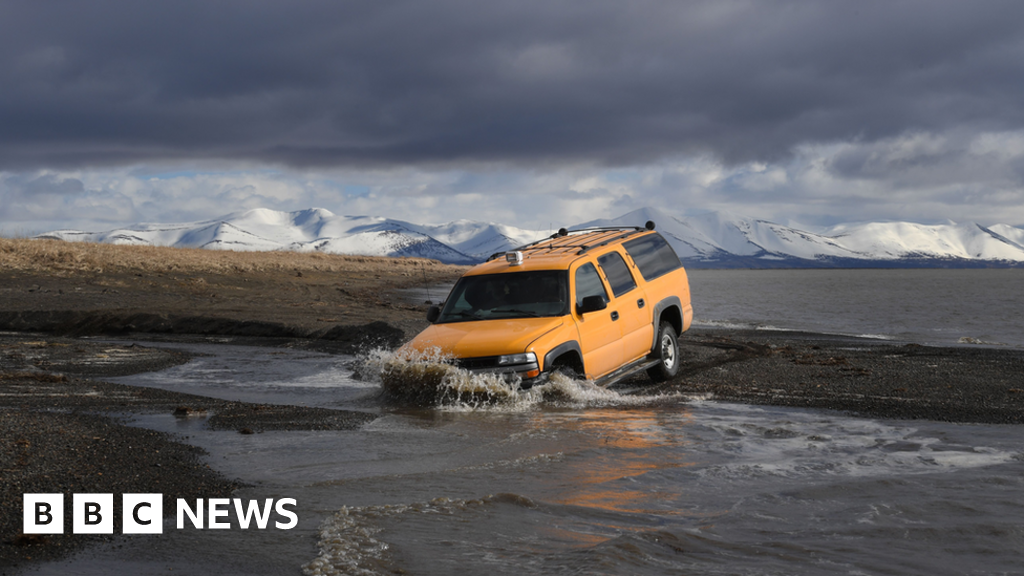Image copyright
Getty Images
Melting permafrost in Alaska and other northern regions could unleash large amounts of warming gases from peatlands
The world’s peatlands will become a large source of greenhouse gases as temperatures rise this century, say scientists.
Right now, huge amounts of carbon are stored in boggy, often frozen regions stretching across northern parts of the world.
But much of the permanently frozen land will thaw this century, say experts.
This will release warming gases at a rate that could be 30-50% greater than previous estimates.
Stretching across vast regions of the northern half of the world, peatlands play an important role in the global climate system.
Over thousands of years, they have accumulated large amounts of carbon and nitrogen, which has helped keep the Earth cool.
Image copyright
Gustaf Hugelius
The eroding edge of a permafrost peat plateau in the western Russian Arctic
Scientists, though, are keenly aware that peatlands – including the nearly half that are permanently frozen – are very vulnerable to rising temperatures.
But, until now, a lack of accurate maps has made it difficult to fully estimate the impact of climate on peat.
Using data compiled from more than 7,000 field observations, the authors of this new study were able to generate the most accurate maps to date of the peatlands, their depth and the amount of warming gases they contain.
They show that the boggy terrain covers 3.7 million sq kilometres (1.42 million sq miles).
Image copyright
Gustaf Hugelius
A degrading permafrost peat mound in Sweden
The researchers say the northern peatlands store around 415 gigatonnes of carbon. That’s roughly equivalent to 46 years of current global CO2 emissions.
In their study, the authors projected that the peatlands would become a major source of CO2 as the world warms up.
One key question is when this will happen.
“Unfortunately, we cannot put exact times to these numbers so far, the models are not that advanced yet,” said lead author Gustaf Hugelius from Stockholm University, Sweden.
“But my best estimate is that this shift will occur in the second half of this century.”
So what would be the likely impact of this thawing?
The report authors say that their new estimate of the carbon emitted through thawing, and from losses of peat into rivers and streams, is 30-50% greater than in previous projections of carbon losses from permafrost thawing.
Image copyright
Gustaf Hugelius
An aerial view of peatland in Siberia
If this new peatland estimate is included with all the estimates for permafrost melting, it is projected to equal the annual emissions of the EU and UK by 2100.
“The only way to limit the permafrost carbon feedback is to reduce global warming,” said Dr Hugelius.
“Because the Arctic warms twice as fast as the rest of the globe, the higher warming pathways that we are on now are devastating for the permanently frozen parts of the globe.”
While the future for peatlands frozen or otherwise, in a warmer world is undeniably difficult. it is not without hope.
Experts say that with the right investment to protect and restore non-frozen peatlands, the bogs can continue to soak up and store large amounts of CO2.
Similarly, as frozen peat thaws out it starts to become capable of growing plants and storing warming gases.
While the new study says it might take a couple of centuries for peatlands to start absorbing large amounts of CO2, others believe it might happen much sooner.,
“If the climate warms and the conditions are better for the vegetation, vegetation can respond in a matter of decades,” said Clifton Bain, who is the director of the IUCN UK Peatland Programme.
“We’ve seen in the UK when you destroy a peatland and rip away the surface vegetation and drain it, if you re-wet it and there’s a source of sphagnum moss there, they will re grow within a matter of decades. So, it is possible in the right conditions for the bulk vegetation to recover very quickly.”
The study has been published in the journal Proceedings of the National Academy of Sciences.
Follow Matt on Twitter.

